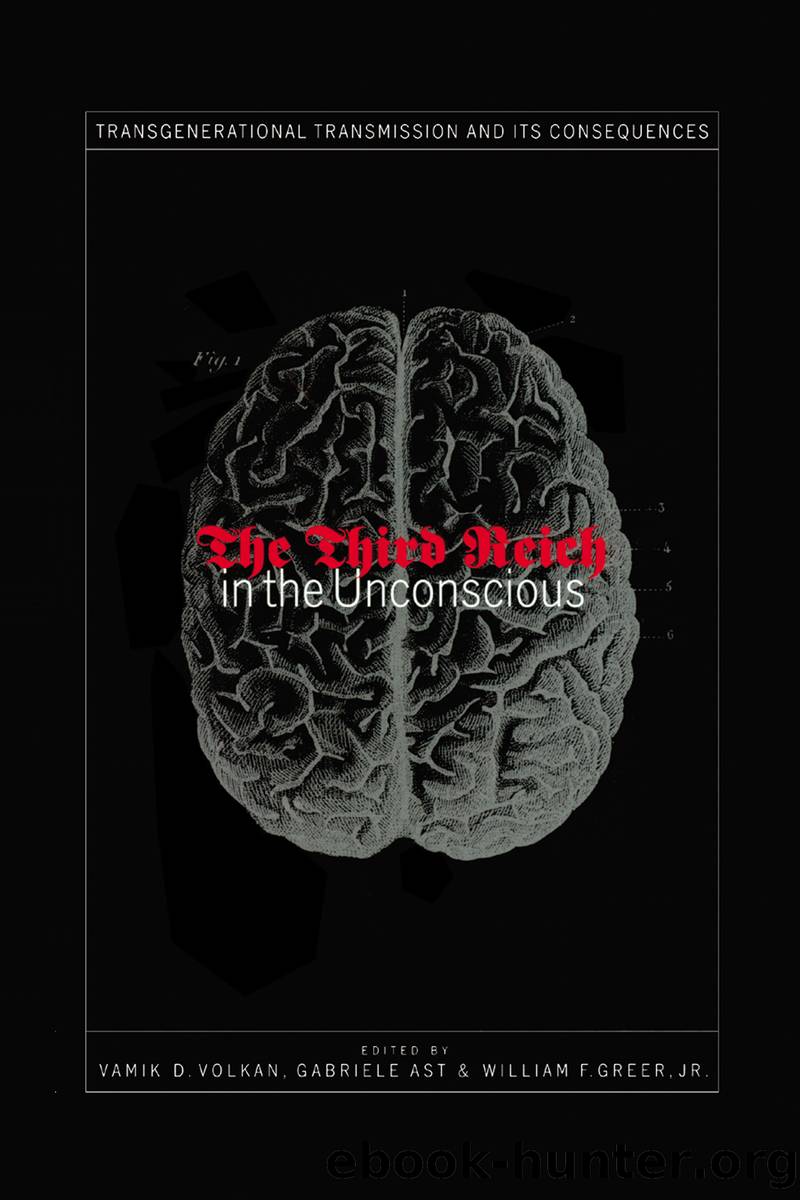Third Reich in the Unconscious by Volkan Vamik D.;Ast Gabriele;Greer William F. Jr.;

Author:Volkan, Vamik D.;Ast, Gabriele;Greer, William F., Jr.;
Language: eng
Format: epub
Publisher: Taylor & Francis Group
Published: 2002-08-15T00:00:00+00:00
Uta's Personal History
Uta was born in a small, conservative German town close to Frankfurt, where, at the time of her birth, her mother was a manual worker in a shoe factory. Her father worked as a laborer in various food processing companies whenever jobs were available. In his late 40s, when Uta was 10 years old, he retired after suffering a heart attack. Utaâs fatherâs surname clearly identified his family as Gypsies in the eyes of the settled German population. Uta did not know how her parents had survived the Nazi period, though her mother had hinted that the family had passed as non-Gypsy/non-Traveler. Indeed, all of Utaâs information about her parentsâ lives before she was old enough to observe them herself was rather sparse.
Married to a non-Traveler German who was a railroad conductor in a small town near Frankfurt, Utaâs Traveler maternal grandmother had given birth to 13 children, of whom Utaâs mother and her motherâs elder sister were the oldest. Because nomadic people were not allowed to go to school during this time, Utaâs mother barely knows how to read and write; Utaâs father was also functionally illiterate. At the age of 6, Utaâs mother went to work on a German farm from which she would return to her home each night. It is not clear if her âhomeâ was in a slave labor camp for nomadic persons; Utaâs mother would not reveal direct information about this question. Nevertheless, she recalled how, as a small child, she would look from a window of their âhomeâ and see a light in a distant house. Where she lived, it seems, there was no light at night; she described the distant light as providing her an orientation in time and space. To this day, Utaâs mother gazes at lights in the houses in her neighborhood before going to sleep.
At the end of the war, when she was 13, Utaâs mother began to work on another German-owned farm, where she slept with the animals in the barn; she recalled âlearning to speak with the animals.â At this time, Utaâs motherâs parents were separated, leaving the abandoned wife with many young children to raise. To help her beleaguered mother, Utaâs mother often brought food from the farm to her younger siblings; in fact, from 1945 on, Utaâs mother essentially fended for herself. In 1950, Utaâs mother married Utaâs father, who was three years older. It was around this time that she became obsessed with cleanliness. So ashamed of being called a Gypsy as a child, she decided that her children should never experience such shame.
When she began her analysis, Uta had even less information about her fatherâs side of the family before his marriage to her mother. Originally, Utaâs father was married to her motherâs older sister, and the couple had had one child. When the child was 3 years old, his mother (Utaâs aunt) was killed in a motorcycle accident after a party. The motorcycle was driven by one of the fatherâs brothers.
Download
This site does not store any files on its server. We only index and link to content provided by other sites. Please contact the content providers to delete copyright contents if any and email us, we'll remove relevant links or contents immediately.
Application of a Novel Technique for Clinical Evaluation of Nitric Oxide-Induced Free Radical Reactions in ICU Patients by Unknown(696)
Rosenâs Emergency Medicine Concepts and Clinical Practice by Ron Walls; Robert Hockberger; Marianne Gausche-Hill; Timothy B. Erickson; Susan R. Wilcox(572)
Oxidative damage to surfactant protein D in pulmonary diseases by Vitality Starosta1 & Matthias Griese1†(408)
Social Science Perspectives on Global Public Health by Vincent La Placa & Julia Morgan(375)
Constructing Canine Consent; Conceptualising and Adopting a Consent-focused Relationship with Dogs by ERIN JONES(330)
Organic Chemistry: An Acid - Base Approach by MICHAEL SMITH(300)
ADVANCED EMERGENCY CARE AND TRANSPORTATION OF THE SICK AND INJURED by Unknown(271)
Saunders Nursing Drug Handbook 2024 - E-Book by Unknown(263)
Davis's Comprehensive Manual of Laboratory and Diagnostic Tests with Nursing Implications by Unknown(249)
Socio-Life Science and the COVID-19 Outbreak : Public Health and Public Policy by Makoto Yano; Fumihiko Matsuda; Anavaj Sakuntabhai; Shigeru Hirota(247)
Diagnostic and Statistical Manual of Mental Disorders, Fifth Edition, Text Revision (DSM-5-TR(tm)) by Unknown(246)
Human Microanatomy; Cell Tissue and Organ Histology with Celebrity Medical Histories by Stephen A. Stricker(245)
Berne and Levy Physiology E-Book by Unknown(236)
Replacing the Dead by Mie Nakachi;(231)
Handbook of Skin Disease Management by Jiyad Zainab;Flohr Carsten; & Carsten Flohr(229)
Access to Medicines and Vaccines in the South : Coherence of Rules and Policies Applied by the European Union Commission by Stephen Kingah(226)
Deep Learning and Medical Applications by Unknown(222)
The Pocket Guide to Sensorimotor Psychotherapy in Context (Norton Series on Interpersonal Neurobiology) by Pat Ogden(218)
Advances and Technical Standards in Neurosurgery by Unknown(215)
